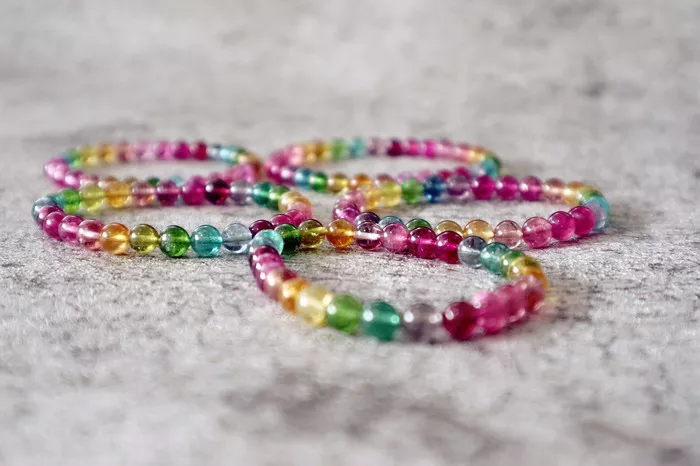Green tourmaline, also known as verdelite, is a variety of the tourmaline mineral group. It is renowned for its unique color, glass-likex gloss, and physical properties. This article will explore whether green tourmaline can be classified as a precious stone from a professional jewelry appraiser’s perspective. We will delve into its characteristics, rarity, uses, and comparison with other gemstones to provide a comprehensive understanding.
Characteristics of Green Tourmaline
Green tourmaline is a silicate mineral composed of complex boron aluminum silicate with trace elements such as lithium, sodium, magnesium, and iron. Its chemical formula is complex and varies slightly depending on the specific composition, but it generally falls into the category of sodium lithium aluminum boron silicate.
Color and Appearance
Green tourmaline typically displays shades ranging from light green to dark green, with some specimens exhibiting a golden hue. The color is primarily due to the presence of iron and chromium impurities within the mineral structure. The gemstone has a glass-like gloss, appearing transparent to translucent. Some varieties may exhibit chatoyancy, a phenomenon where light reflects off internal inclusions to create a cat’s-eye effect.
Physical Properties
Green tourmaline is relatively hard, with a hardness rating of 7 to 7.5 on the Mohs scale, making it suitable for jewelry that withstands daily wear and tear. Its specific gravity ranges from 3.01 to 3.25, which is higher than many other gemstones. This density contributes to its substantial feel when held.
The refractive index of green tourmaline is between 1.620 and 1.650, with a birefringence of 0.014 to 0.021. This birefringence is responsible for the stone’s strong pleochroism, where it appears different colors depending on the viewing angle. It is a uniaxial negative crystal, meaning it has a single optical axis with negative optical properties.
Optical Effects and Inclusions
Green tourmaline often contains internal inclusions such as liquid or gaseous cavities, parallel fibers, and needle-like crystals. These inclusions can affect the clarity and appearance of the gemstone but also add to its uniqueness and character. Some collectors and jewelers appreciate the natural imperfections that make each gemstone one-of-a-kind.
Sources and Occurrences
Green tourmaline is found in various locations worldwide, with significant deposits in Brazil, Madagascar, Sri Lanka, and the United States (California and Maine). Each deposit often yields tourmaline with unique colorations and physical properties.
For example, Sri Lanka is known for producing high-quality green tourmaline with a rich, saturated color. Brazilian deposits often yield larger crystals with varying shades of green. Madagascar’s tourmaline can exhibit unique color combinations and patterns.
Classification and Value
The classification of a gemstone as precious or semiprecious is somewhat subjective and varies across cultures and historical periods. Traditionally, precious stones include diamonds, rubies, sapphires, and emeralds, while semiprecious stones encompass a broader range of gemstones.
Green tourmaline, while not traditionally considered a precious stone, is highly valued and sought after for its unique color, hardness, and stability. Its value is influenced by several factors, including color saturation, clarity, cut, carat weight, and origin.
Color
Color is the most critical factor determining the value of green tourmaline. The most desirable shades are those with a high saturation and purity, such as a rich emerald green. Stones with lighter or more yellowish tones may be less valuable.
Clarity
Clarity refers to the absence of inclusions and blemishes within the gemstone. Cleaner stones with fewer inclusions are generally more valuable. However, some collectors appreciate stones with unique inclusions that add to their character.
Cut and Shape
The cut and shape of the gemstone can significantly impact its appearance and value. Well-cut green tourmaline will maximize its brilliance and fire, making it more attractive and valuable. Popular cuts include round, oval, emerald, and cushion shapes.
Carat Weight
As with most gemstones, larger stones are generally more valuable. However, the quality of the stone is equally important. A well-cut, high-quality green tourmaline of moderate size can be more valuable than a larger, poorly cut stone.
Origin
The origin of the gemstone can also affect its value. Stones from well-known deposits with a reputation for producing high-quality material, such as Sri Lanka, may fetch a higher price.
Comparison with Other Gemstones
Green tourmaline is often compared to other green gemstones, such as emeralds and peridots. Each gemstone has unique characteristics that set it apart.
Emeralds
Emeralds are a variety of the beryl mineral group and are renowned for their vivid green color. They are considered precious stones and are often more valuable than green tourmaline. However, emeralds are typically more included, with visible fractures and fissures that can affect their durability.
Peridots
Peridots are magnesium iron silicates and are typically found in shades of olive green to yellow-green. They are less rare and valuable than green tourmaline, but they have their own unique charm and appeal.
Uses and Applications
Green tourmaline is widely used in jewelry, including rings, earrings, necklaces, and bracelets. Its durability and attractive color make it a popular choice for everyday wear and special occasions.
In addition to jewelry, green tourmaline is also used in industrial applications due to its piezoelectric and pyroelectric properties. It can be used in electronic devices, sensors, and medical equipment.
Conclusion
In summary, green tourmaline is a gemstone with unique characteristics and a rich history. Its value is determined by various factors, including color, clarity, cut, carat weight, and origin. While it may not be classified as a precious stone in the traditional sense, it is still highly valued and treasured for its beauty and uniqueness.
Related topic:
- Where to Find Pink Tourmaline
- Can Pink Tourmaline Be Worn Everyday
- When Should You Not Wear Tourmaline


